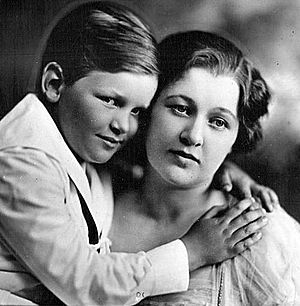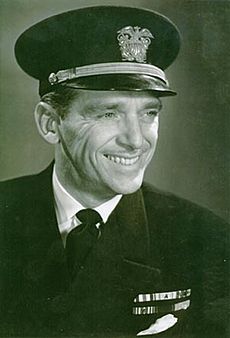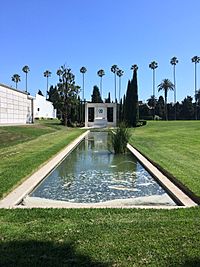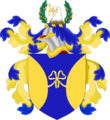Douglas Fairbanks Jr. facts for kids
Quick facts for kids
Douglas Fairbanks Jr.
|
|
|---|---|
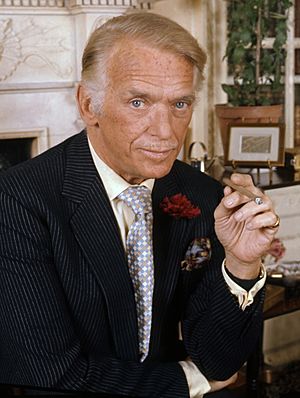
Fairbanks in 1973, by Allan Warren
|
|
| Born |
Douglas Elton Fairbanks Jr.
December 9, 1909 New York City, U.S.
|
| Died | May 7, 2000 (aged 90) New York City, U.S.
|
| Occupation |
|
| Years active | 1916–1997 |
| Spouse(s) |
Mary Lee Epling
(m. 1939; died 1988)Vera Shelton
(m. 1991) |
| Children | 3 |
| Parent(s) |
|
| Relatives | Jack Whiting (stepfather) |
| Military career | |
| Allegiance | |
| Service/ |
|
| Years of service | 1941–1954 |
| Rank | |
| Unit | Beach Jumpers |
| Battles/wars | World War II |
| Awards | |
Douglas Elton Fairbanks Jr. (December 9, 1909 – May 7, 2000) was a famous American actor, producer, and a brave naval officer during World War II. He was known for his roles in exciting films like The Prisoner of Zenda (1937), Gunga Din (1939), and The Corsican Brothers (1941). His father was the legendary actor Douglas Fairbanks, and his stepmother was Mary Pickford. Douglas Fairbanks Jr. was briefly married to actress Joan Crawford.
Contents
Early Life and Education
Douglas Elton Fairbanks Jr. was born in New York City. He was the only child of the famous actor Douglas Fairbanks and his first wife, Anna Beth Sully. His father was one of the first big movie stars, famous for adventure films like The Mark of Zorro and Robin Hood. Douglas Jr. even had small parts in his father's movies when he was very young.
His parents divorced when he was nine years old. Douglas Jr. then lived with his mother in different cities, including New York, Paris, and London. He went to several schools, including the Hollywood School for Boys and Harvard Military School. He also attended a special after-school drill academy called Knickerbocker Greys.
Becoming a Movie Star
Starting in Hollywood
When Douglas Fairbanks Jr. was just 13, he got a movie contract with Paramount Pictures. This was largely because of his father's fame. He was supposed to star in a film about Tom Sawyer, but that movie was never made. Instead, he appeared in Stephen Steps Out (1923), which wasn't a big success.
After a short break, he returned to Hollywood. He wanted to build his acting career carefully. He took on supporting roles in films like The Air Mail (1925).
First Big Successes
Fairbanks Jr. got his first big break in the film Stella Dallas (1925). This movie was a hit and helped his career. He continued to appear in supporting roles in various films.
In 1927, he made his first appearance on stage in a play called Young Woodley. He received great reviews for his performance. This play really helped improve his reputation in Hollywood. It was also around this time that he met and fell in love with actress Joan Crawford.
From Supporting Roles to Leading Man
Douglas Fairbanks Jr. slowly started getting more important roles. He starred in films like The Power of the Press (1928), directed by Frank Capra. He also appeared in his first "talkie" (a movie with sound), The Barker (1928). He often starred opposite Loretta Young in films like Fast Life.
In 1929, he appeared in Our Modern Maidens with Joan Crawford, whom he married that year. He continued to get leading roles in films like The Careless Age (1929).
Breaking Through with Little Caesar
A major turning point came in 1930 when he starred in The Dawn Patrol, directed by Howard Hawks. Then, in 1931, he played a key role alongside Edward G. Robinson in the gangster movie Little Caesar. This film was a huge success and is now considered a classic.
After Little Caesar, Warner Bros. offered him a special contract. This contract allowed him to approve the cast, story, and director for his films. This was a very rare privilege for an actor his age! He wanted to avoid adventure films, which were his father's specialty. He starred in films like Chances (1931) and Morning Glory (1933) with Katharine Hepburn.
In 1934, he left Hollywood for a few years and moved to London. He felt that Hollywood was making too many movies too quickly.
Back to Action Films
Fairbanks Jr. returned to Hollywood when he was offered a role in The Prisoner of Zenda (1937). His father encouraged him to take the part, saying it was a great role for an actor. The movie was a big hit.
He then signed a contract with RKO to make two films a year. He started starring in more action and adventure films. His biggest hit was Gunga Din (1939), where he starred with Cary Grant. He also made The Corsican Brothers (1941), which was a tribute to his father's swashbuckling style. This film was also very successful.
World War II Service
When the United States entered World War II, Douglas Fairbanks Jr. joined the United States Navy as an officer. He worked with Lord Mountbatten's commando staff in the United Kingdom.
In 1941, President Franklin D. Roosevelt sent him as a special representative to South America. He also served on a ship during a dangerous operation called Convoy PQ 17.
Fairbanks Jr. later came up with an amazing idea for a special military unit. This unit, called the Beach Jumpers, would pretend to be a much larger invasion force. They would use special equipment to trick the enemy into thinking the main attack was happening somewhere else. This would draw enemy attention away from the real landing sites.
The Beach Jumpers first saw action during Operation Husky, the invasion of Sicily. They continued to perform these risky deception missions throughout the war.
For his brave planning and actions in the war, Douglas Fairbanks Jr. received many important awards. These included the American Legion of Merit and Silver Star. He also received awards from other countries, such as the Italian War Cross for Military Valor, the French Légion d'honneur and Croix de Guerre, and the British Distinguished Service Cross.
He stayed in the US Naval Reserve after the war and eventually became a captain in 1954.
After the War
Back to Hollywood and British Life
After World War II, Fairbanks Jr. returned to Hollywood. He starred in films like Sinbad the Sailor (1947) and The Exile (1947), which he also wrote and produced. However, these films were not as successful as his earlier ones.
Douglas Fairbanks Jr. loved the United Kingdom and spent a lot of time there. He was well-known in British society. In 1949, he was made an Honorary Knight Commander of the Order of the British Empire (KBE). He moved to the UK in the early 1950s.
He continued to act in British films, such as the thriller State Secret (1950). Between 1954 and 1956, he also produced and starred in a TV show called Douglas Fairbanks Presents.
Later Career and Other Ventures
Fairbanks Jr. appeared as a guest on many American television shows in the 1950s. He also co-produced films like The Silken Affair (1957).
He continued to act on stage, touring in plays like My Fair Lady. He also appeared in TV movies and series, including The Love Boat. His last feature film was Ghost Story (1981).
Besides acting, Fairbanks Jr. was also a successful businessman. He was involved in making ballpoint pens, real estate, and managing plays.
He wrote two autobiographies: The Salad Days (1988) and A Hell of a War (1993), which described his experiences during World War II.
Personal Life
Douglas Fairbanks Jr.'s first marriage was to actress Joan Crawford in 1929. He was 19, and she was four years older. They divorced in 1933. Even after their divorce, he defended Joan Crawford when a book was written about her. He said the person described in the book was not the Joan Crawford he knew.
In 1939, he married Mary Lee Hartford. They were married until her death in 1988. They had three daughters: Daphne, Victoria, and Melissa. In 1991, he married Vera Lee Shelton.
Fairbanks Jr. was good friends with many famous people, including actors Laurence Olivier and Rex Harrison.
Death and Legacy
Douglas Fairbanks Jr. passed away on May 7, 2000, at the age of 90, from a heart attack. He was buried at the Hollywood Forever Cemetery in Hollywood, California, in the same tomb as his father.
He has three stars on the Hollywood Walk of Fame for his work in movies, television, and radio. In 1969, he was added to the International Best Dressed List.
His personal belongings were sold at an auction in 2011, raising over $500,000.
Filmography
| Year | Film | Role | Director |
|---|---|---|---|
| 1916 | American Aristocracy | Newsboy (uncredited) | Lloyd Ingraham |
| 1921 | The Three Musketeers | Boy (uncredited) | Fred Niblo |
| 1923 | Stephen Steps Out | Stephen Harlow Jr. | Joseph Henabery |
| 1925 | The Air Mail | Sandy | Irvin Willat |
| 1925 | Wild Horse Mesa | Chess Weymer | George B. Seitz |
| 1925 | Stella Dallas | Richard Grosvenor | Henry King |
| 1926 | The American Venus | Triton | Frank Tuttle |
| 1926 | Padlocked | Sonny Galloway | Allan Dwan |
| 1926 | Broken Hearts of Hollywood | Hal Terwilliger | Lloyd Bacon |
| 1927 | Man Bait | Jeff Sanford | Donald Crisp |
| 1927 | Women Love Diamonds | Jerry Croker-Kelley | Edmund Goulding |
| 1927 | Is Zat So? | G. Clifton Blackburn | |
| 1927 | A Texas Steer | Farleigh Bright | Richard Wallace |
| 1928 | Dead Man's Curve | Vernon Keith | Richard Rosson |
| 1928 | Modern Mothers | David Starke | Phil Rosen |
| 1928 | The Toilers | Steve | Reginald Barker |
| 1928 | The Power of the Press | Clem Rogers | Frank Capra |
| 1928 | The Barker | Chris Miller | George Fitzmaurice |
| 1928 | A Woman of Affairs | Jeffry Merrick | Clarence Brown |
| 1929 | The Jazz Age | Steve Maxwell | Lynn Shores |
| 1929 | Fast Life | Douglas Stratton | John Francis Dillon |
| 1929 | Our Modern Maidens | Gil | Jack Conway |
| 1929 | The Careless Age | Wyn | John Griffith Wray |
| 1929 | The Forward Pass | Marty Reid | Edward F. Cline |
| 1929 | The Show of Shows | Ambrose in 'Bicycle Built for Two' Number | John G. Adolfi |
| 1930 | Party Girl | Jay Rountree | Victor Halperin |
| 1930 | Loose Ankles | Gil Hayden | Ted Wilde |
| 1930 | The Dawn Patrol | Douglas Scott | Howard Hawks |
| 1930 | The Little Accident | Norman Overbeck | William James Craft |
| 1930 | The Way of All Men | Billy Bear | Frank Lloyd |
| 1930 | Outward Bound | Henry | Robert Milton |
| 1930 | One Night at Susie's | Dick Rollins | John Francis Dillon |
| 1931 | Little Caesar | Joe Massara | Mervyn LeRoy |
| 1931 | L'aviateur | ||
| 1931 | Chances | Jack Ingleside | Allan Dwan |
| 1931 | I Like Your Nerve | Larry O'Brien | William C. McGann |
| 1932 | Union Depot | Chick Miller | Alfred E. Green |
| 1932 | It's Tough to Be Famous | Scott 'Scotty' McClenahan | Alfred E. Green |
| 1932 | L'athlète incomplete | Fred Miller | |
| 1932 | Love Is a Racket | Jimmy Russell | William A. Wellman |
| 1932 | Scarlet Dawn | Nikita Krasnoff | William Dieterle |
| 1933 | Parachute Jumper | Bill Keller | Alfred E. Green |
| 1933 | The Life of Jimmy Dolan | Jimmy Dolan aka Jack Dougherty | Archie Mayo |
| 1933 | The Narrow Corner | Fred Blake | Alfred E. Green |
| 1933 | Morning Glory | Joseph Sheridan | Lowell Sherman |
| 1933 | Captured! | Lt. Jack 'Dig' Digby | Roy Del Ruth |
| 1934 | The Rise of Catherine the Great | Grand Duke Peter | Paul Czinner |
| 1934 | Success at Any Price | Joe Martin | J. Walter Ruben |
| 1935 | Mimi | Rodolphe | Paul L. Stein |
| 1935 | Man of the Moment | Tony | Monty Banks |
| 1936 | The Amateur Gentleman | John Beverley aka Barnabas Barty | Thornton Freeland |
| 1936 | Accused | Tony Seymour | Thornton Freeland |
| 1937 | Jump for Glory | Ricky Morgan | Raoul Walsh |
| 1937 | The Prisoner of Zenda | Rupert of Hentzau | W. S. Van Dyke (uncredited) |
| 1938 | Joy of Living | Dan Brewster | Tay Garnett |
| 1938 | The Rage of Paris | Jim Trevor | Henry Koster |
| 1938 | Having Wonderful Time | Chick Kirkland | James Anderson (assistant) |
| 1938 | The Young in Heart | Richard Carleton | Richard Wallace |
| 1939 | Gunga Din | Ballantine | George Stevens |
| 1939 | The Sun Never Sets | John Randolph | Rowland V. Lee |
| 1939 | Rulers of the Sea | David Gillespie | Frank Lloyd |
| 1940 | Green Hell | Keith Brandon | James Whale |
| 1940 | Safari | Jim Logan | Edward H. Griffith |
| 1940 | Angels Over Broadway | Bill O'Brien | Lee Garmes (co-director) |
| 1941 | The Corsican Brothers | Mario Franchi / Lucien Franchi | Gregory Ratoff |
| 1947 | Sinbad the Sailor | Sinbad | Richard Wallace |
| 1947 | The Exile | Charles Stuart (Charles II) | Max Ophüls (as Max Opuls) |
| 1948 | That Lady in Ermine | Colonel Ladislas Karolyi Teglas / The Duke | Otto Preminger (but completed the film) |
| 1949 | The Fighting O'Flynn | The O'Flynn | Arthur Pierson |
| 1950 | State Secret | Dr. John Marlowe | Sidney Gilliat |
| 1951 | Mister Drake's Duck | Donald 'Don' Drake | Val Guest |
| 1953 | The Genie | The Genie (segment "The Genie") | |
| 1953 | Three's Company | Narrator / Anthony (segment "The Scream' story) | |
| 1953 | The Triangle | François Villon (segment "A Lodging for the Night") | |
| 1954 | Thought to Kill | Narrator | |
| 1954 | The Red Dress | Narrator | |
| 1954 | The Last Moment | George Griffin | |
| 1954 | Destination Milan | ||
| 1956 | Faccia da mascalzone | ||
| 1958 | Chase a Crooked Shadow | Michael Anderson | |
| 1967 | Red and Blue | Millionaire | |
| 1972 | The Crooked Hearts | Rex Willoughby | Jay Sandrich |
| 1978 | Kingdom of Gifts | The Proud King (voice) | |
| 1980 | The Hostage Tower | Malcolm Philpott | Claudio Guzmán |
| 1981 | Ghost Story | Edward Wanderley | John Irvin |
| 1987 | Strong Medicine | Eli Camperdown |
Radio Appearances
| Year | Program | Episode/source |
|---|---|---|
| 1946 | Screen Guild Players | The Old Lady Shows Her Medals |
Awards and Honors
- Silver Star
- Legion of Merit
- American Defense Service Medal
- American Campaign Medal
- European-African-Middle Eastern Campaign Medal
- World War II Victory Medal
- Naval Reserve Medal
- Knight Commander of the Order of the British Empire, 1949 (KBE, United Kingdom)
- Knight of the Order of St John (KStJ, United Kingdom)
- Knight of the Legion of Honor (France)
- Officer of the Order of the Southern Cross (Brazil)
- Distinguished Service Cross (United Kingdom)
- Croix de Guerre, 1939–1945 with bronze palm (France)
- War Cross for Military Valor (Italy)
- Federal Cross of Merit, Commander's Cross (West Germany)
Images for kids
See also
 In Spanish: Douglas Fairbanks, Jr. para niños
In Spanish: Douglas Fairbanks, Jr. para niños


